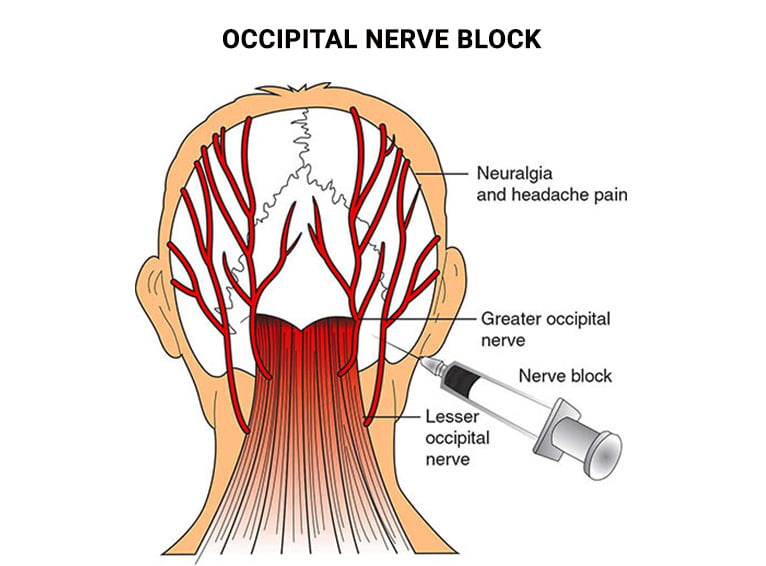Occipital nerves in your cervical spine provide sensory information to your scalp, sometimes resulting in headaches, migraines, and neck pain when irritated. To effectively address neuropathic head pain and occipital neuralgia, see the medical experts at Advanced Headache Center in NYC and NJ for interventional treatment such as occipital nerve block. The team of multi-disciplinary headache specialists with expert knowledge of head and neck anatomy provides long-term pain relief by blocking these nerves and decreasing the severity and frequency of headaches.
What Is An Occipital Nerve Block?
An occipital nerve block is available to patients with moderate to severe chronic neuralgia or other types of headaches associated with the occipital nerve. These may include types of pain that start at the back of the head near the neck and then radiate outward throughout the skull. An occipital nerve block inhibits the disproportionate or chronic signals sent to the brain, processed, and perceived as headache pain. Occipital nerve blocks are injections directed into the tissue around the occipital nerves to decrease inflammation and swelling and decrease pain.

Why You May Need an Occipital Neuralgia Nerve Block
Occipital neuralgia is a neurological condition that can result in pain in the back of your head, neck, and upper shoulders. This type of chronic headache disorder is caused by the irritation or inflammation of the occipital nerves that run through your scalp. An occipital nerve block is an injection of local anesthetic and steroids near an occipital nerve to relieve the pain associated with this condition.
Several other conditions that can be helped by this treatment option include:
- Migraines. Occipital nerve blocks have been shown to be effective in treating migraines, even though they aren’t directly caused by occipital neuralgia. It’s possible to reduce the severity and frequency of migraines by blocking the pain signals from the occipital nerves.
- Cervicogenic headaches. These headaches are caused by pain in the neck and can often be mistaken for migraines. Occipital nerve blocks have proven to be an effective tool in the management of cervicogenic head pains.
- Trigeminal neuralgia. This is a condition that causes intense facial pain. While occipital nerve blocks are not a primary treatment for trigeminal neuralgia, they can be used to help manage the pain associated with this condition.
- Cluster headaches. Cluster headaches are a type of headache that occurs in cycles or clusters. Injecting a combination of pain medicine and steroids in the back of your head can be an effective way to manage this type of head pain.
The greater occipital nerve block is a viable and safe therapeutic option for a variety of headache conditions. The steroid helps to reduce inflammation at the exact site where it is the most critical, avoiding the possible adverse effects of taking a steroid or other drugs orally, which can then move to other areas of the body. By lowering inflammation, the steroid may aid in nerve healing. It may also offer long-term relief or relief over a few weeks/months while the nerve heals.
What Are the Steps of the Occipital Nerve Block Procedure
The occipital nerve block procedure involves injecting a small amount of medication into the occipital nerves to block pain signals, which usually takes a variety of steps, such as:
- The doctor will ask you to lie down on your stomach or sit in a comfortable position with your head slightly tilted forward.
- The specialist will sterilize the area where the injection will be administered to reduce the risk of infection.
- A local anesthetic will be administered to numb the injection site and reduce any discomfort.
- The doctor will then use a small needle to inject a mixture of anesthetic and steroid medication into the occipital nerves using ultrasound or X-ray imaging to ensure that the medication is delivered to the correct location.
- After the injection, you will be monitored for a short period to ensure that there are no adverse reactions.
Once the procedure is over, you will be given instructions on how to care for the injection site and when to schedule a follow-up appointment with your doctor.
What Are the Risks and Side Effects of the Occipital Nerve Block
Some of the most common risks and side effects associated with the occipital nerve block:
- Bleeding at the injection site
- Infection
- Allergic reaction
- Nerve damage
- Headache
- Facial flushing or redness at the injection site.
If you are experiencing increasing pain or fever-like symptoms, please contact our doctor immediately. Remember that the steroid medication’s pain-killing effects won’t kick in until two or three days following your occipital nerve block treatment. Avoid strenuous activity while you’re waiting for the meds to begin working. You can resume your daily routine after the discomfort has subsided.
At Advanced Headache Center, we aim to get you started on a personalized treatment plan to find relief. Visit an interprofessional team of pain management professionals at one of our offices throughout NYC or NJ and discover firsthand why so many patients consider us the best pain and nerve specialists providing occipital nerve blocks for occipital neuralgia, refractory migraine disorder, and myofascial neck pain.

Dr. Hosny is an Ivy League Trained, UCNS-accredited, board-certified headache specialist who offers the latest preventive and abortive treatments to provide safe and effective head pain relief. As an active member of prominent organizations and professional societies that advance headache science, education, and management, such as the National Headache Foundation, Dr. Hosny specializes in diagnosing and treating a wide range of head pain disorders, including tension headaches, migraines, and cluster headaches, to name a few.
Dr. Hosny's reputation for enhancing headache care quality through the use of the most effective and technologically advanced treatment options for persistent primary and secondary chronic headaches has been acknowledged by Castle Connolly and Healthgrades, where he has received over 200 positive reviews. Dr. Hosny is also recognized as a distinguished New York City physician and headache specialist by New York Magazine.
More about Dr. HosnyNew York, NY 10003
(646) 763-2222




